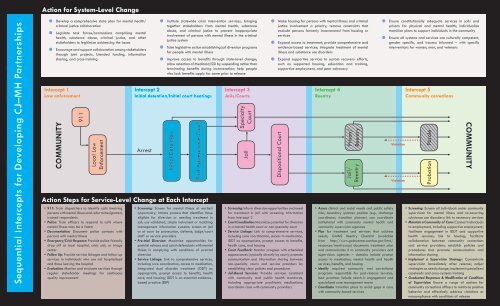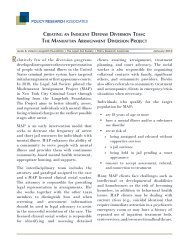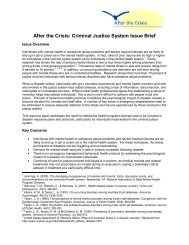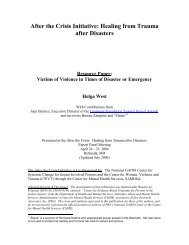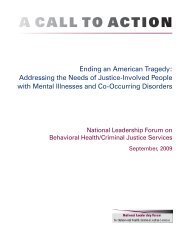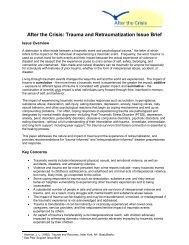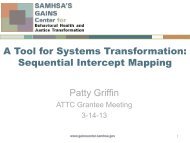Sequential Intercept Model - SAMHSA'S GAINS Center for ...
Sequential Intercept Model - SAMHSA'S GAINS Center for ...
Sequential Intercept Model - SAMHSA'S GAINS Center for ...
Create successful ePaper yourself
Turn your PDF publications into a flip-book with our unique Google optimized e-Paper software.
Action <strong>for</strong> System-Level Change<br />
<strong>Sequential</strong> <strong>Intercept</strong>s <strong>for</strong> Developing CJ–MH Partnerships<br />
Develop a comprehensive state plan <strong>for</strong> mental health/<br />
criminal justice collaboration<br />
Legislate task <strong>for</strong>ces/commissions comprising mental<br />
health, substance abuse, criminal justice, and other<br />
stakeholders to legitimize addressing the issues<br />
Encourage and support collaboration among stakeholders<br />
through joint projects, blended funding, in<strong>for</strong>mation<br />
sharing, and cross-training<br />
<strong>Intercept</strong> 1<br />
Law en<strong>for</strong>cement<br />
COMMUNITY<br />
911<br />
Local Law<br />
En<strong>for</strong>cement<br />
Action Steps <strong>for</strong> Service-Level Change at Each <strong>Intercept</strong><br />
• 911: Train dispatchers to identify calls involving<br />
persons with mental illness and refer to designated,<br />
trained respondents<br />
• Police: Train officers to respond to calls where<br />
mental illness may be a factor<br />
• Documentation: Document police contacts with<br />
persons with mental illness<br />
• Emergency/Crisis Response: Provide police-friendly<br />
drop off at local hospital, crisis unit, or triage<br />
center<br />
• Follow Up: Provide service linkages and follow-up<br />
services to individuals who are not hospitalized<br />
and those leaving the hospital<br />
• Evaluation: Monitor and evaluate services through<br />
regular stakeholder meetings <strong>for</strong> continuous<br />
quality improvement<br />
<strong>Intercept</strong> 2<br />
Initial detention/Initial court hearings<br />
Arrest<br />
Institute statewide crisis intervention services, bringing<br />
together stakeholders from mental health, substance<br />
abuse, and criminal justice to prevent inappropriate<br />
involvement of persons with mental illness in the criminal<br />
justice system<br />
Take legislative action establishing jail diversion programs<br />
<strong>for</strong> people with mental illness<br />
Improve access to benefits through state-level change;<br />
allow retention of Medicaid/SSI by suspending rather than<br />
terminating benefits during incarceration; help people<br />
who lack benefits apply <strong>for</strong> same prior to release<br />
Initial Detention<br />
First Appearance Court<br />
• Screening: Screen <strong>for</strong> mental illness at earliest<br />
opportunity; initiate process that identifies those<br />
eligible <strong>for</strong> diversion or needing treatment in<br />
jail; use validated, simple instrument or matching<br />
management in<strong>for</strong>mation systems; screen at jail<br />
or at court by prosecution, defense, judge/court<br />
staff or service providers<br />
• Pre-trial Diversion: Maximize opportunities <strong>for</strong><br />
pretrial release and assist defendants with mental<br />
illness in complying with conditions of pretrial<br />
diversion<br />
• Service Linkage: Link to comprehensive services,<br />
including care coordination, access to medication,<br />
integrated dual disorder treatment (IDDT) as<br />
appropriate, prompt access to benefits, health<br />
care, and housing; IDDT is an essential evidencebased<br />
practice (EBP)<br />
<strong>Intercept</strong> 3<br />
Jails/Courts<br />
Specialty<br />
Court<br />
Jail<br />
• Screening: In<strong>for</strong>m diversion opportunities and need<br />
<strong>for</strong> treatment in jail with screening in<strong>for</strong>mation<br />
from <strong>Intercept</strong> 2<br />
• Court Coordination: Maximize potential <strong>for</strong> diversion<br />
in a mental health court or non-specialty court<br />
• Service Linkage: Link to comprehensive services,<br />
including care coordination, access to medication,<br />
IDDT as appropriate, prompt access to benefits,<br />
health care, and housing<br />
• Court Feedback: Monitor progress with scheduled<br />
appearances (typically directly by court); promote<br />
communication and in<strong>for</strong>mation sharing between<br />
non-specialty courts and service providers by<br />
establishing clear policies and procedures<br />
• Jail-Based Services: Provide services consistent<br />
with community and public health standards,<br />
including appropriate psychiatric medications;<br />
coordinate care with community providers<br />
Make housing <strong>for</strong> persons with mental illness and criminal<br />
justice involvement a priority; remove constraints that<br />
exclude persons <strong>for</strong>merly incarcerated from housing or<br />
services<br />
Expand access to treatment; provide comprehensive and<br />
evidence-based services; integrate treatment of mental<br />
illness and substance use disorders<br />
Expand supportive services to sustain recovery ef<strong>for</strong>ts,<br />
such as supported housing, education and training,<br />
supportive employment, and peer advocacy<br />
Dispositional Court<br />
<strong>Intercept</strong> 4<br />
Reentry<br />
Prison/<br />
Reentry<br />
Jail/<br />
Reentry<br />
• Assess clinical and social needs and public safety<br />
risks; boundary spanner position (e.g., discharge<br />
coordinator, transition planner) can coordinate<br />
institutional with community mental health and<br />
community supervision agencies<br />
• Plan <strong>for</strong> treatment and services that address<br />
needs; <strong>GAINS</strong> Reentry Checklist (available<br />
from http://www.gainscenter.samhsa.gov/html/<br />
resources/reentry.asp) documents treatment plan<br />
and communicates it to community providers and<br />
supervision agencies – domains include prompt<br />
access to medication, mental health and health<br />
services, benefits, and housing<br />
• Identify required community and correctional<br />
programs responsible <strong>for</strong> post-release services;<br />
best practices include reach-in engagement and<br />
specialized case management teams<br />
• Coordinate transition plans to avoid gaps in care<br />
with community-based services<br />
Ensure constitutionally adequate services in jails and<br />
prisons <strong>for</strong> physical and mental health; individualize<br />
transition plans to support individuals in the community<br />
Ensure all systems and services are culturally competent,<br />
gender specific, and trauma in<strong>for</strong>med – with specific<br />
interventions <strong>for</strong> women, men, and veterans<br />
Violation<br />
Violation<br />
<strong>Intercept</strong> 5<br />
Community corrections<br />
Probation Parole<br />
COMMUNITY<br />
• Screening: Screen all individuals under community<br />
supervision <strong>for</strong> mental illness and co-occurring<br />
substance use disorders; link to necessary services<br />
• Maintain a Community of Care: Connect individuals<br />
to employment, including supportive employment;<br />
facilitate engagement in IDDT and supportive<br />
health services; link to housing; facilitate<br />
collaboration between community corrections<br />
and service providers; establish policies and<br />
procedures that promote communication and<br />
in<strong>for</strong>mation sharing<br />
• Implement a Supervision Strategy: Concentrate<br />
supervision immediately after release; adjust<br />
strategies as needs change; implement specialized<br />
caseloads and cross-systems training<br />
• Graduated Responses & Modification of Conditions<br />
of Supervision: Ensure a range of options <strong>for</strong><br />
community corrections officers to rein<strong>for</strong>ce positive<br />
behavior and effectively address violations or<br />
noncompliance with conditions of release
The <strong>Sequential</strong> <strong>Intercept</strong> <strong>Model</strong><br />
Three Major Responses <strong>for</strong> Every Community<br />
Developed by Mark R. Munetz, MD, and Patricia A.<br />
Griffin, PhD, the <strong>Sequential</strong> <strong>Intercept</strong> <strong>Model</strong> provides<br />
a conceptual framework <strong>for</strong> communities to organize<br />
targeted strategies <strong>for</strong> justice-involved individuals with<br />
serious mental illness. Within the criminal justice system<br />
there are numerous intercept points — opportunities<br />
<strong>for</strong> linkage to services and <strong>for</strong> prevention of further<br />
penetration into the criminal justice system. Munetz<br />
and Griffin (2006) state:<br />
Three Major Responses Are Needed:<br />
1. Diversion programs to keep people with serious mental illness who do not need to<br />
be in the criminal justice system in the community.<br />
2. Institutional services to provide constitutionally adequate services in correctional<br />
facilities <strong>for</strong> people with serious mental illness who need to be in the criminal justice<br />
system because of the severity of the crime.<br />
3. Reentry transition programs to link people with serious mental illness to<br />
community-based services when they are discharged.<br />
The <strong>Sequential</strong> <strong>Intercept</strong> <strong>Model</strong> … can help<br />
communities understand the big picture of<br />
interactions between the criminal justice and<br />
mental health systems, identify where to intercept<br />
individuals with mental illness as they move<br />
through the criminal justice system, suggest which<br />
populations might be targeted at each point of<br />
interception, highlight the likely decision makers<br />
who can authorize movement from the criminal<br />
justice system, and identify who needs to be at<br />
the table to develop interventions at each point<br />
of interception. By addressing the problem at the<br />
level of each sequential intercept, a community<br />
can develop targeted strategies to enhance<br />
effectiveness that can evolve over time.<br />
The <strong>Sequential</strong> <strong>Intercept</strong> <strong>Model</strong> has been used as<br />
a focal point <strong>for</strong> states and communities to assess<br />
available resources, determine gaps in services,<br />
and plan <strong>for</strong> community change. These activities are<br />
best accomplished by a team of stakeholders that<br />
cross over multiple systems, including mental health,<br />
substance abuse, law en<strong>for</strong>cement, pre-trial services,<br />
courts, jails, community corrections, housing, health,<br />
social services, and many others.<br />
Sources<br />
CMHS National <strong>GAINS</strong> <strong>Center</strong>. (2007). Practical advice on jail diversion: Ten years of<br />
learnings on jail diversion from the CMHS National <strong>GAINS</strong> <strong>Center</strong>. Delmar, NY:<br />
Author.<br />
Council of State Governments Justice <strong>Center</strong>. (2008). Improving responses to people<br />
with mental illnesses: The essential elements of a mental health court. New York:<br />
Author.<br />
Munetz, M.R. & Griffin, P.A. (2006). Use of the <strong>Sequential</strong> <strong>Intercept</strong> <strong>Model</strong> as an<br />
approach to decriminalization of people with serious mental illness. Psychiatric<br />
Services, 57(4), 544-549.<br />
Osher, F., Steadman, H.J., & Barr, H. (2002). A best practice approach to community reentry<br />
from jails <strong>for</strong> inmates with co-occurring disorders: The APIC model. Delmar, NY:<br />
National <strong>GAINS</strong> <strong>Center</strong>.<br />
www.consensusproject.org<br />
www.reentrypolicy.org<br />
www.mentalhealthcommission.gov<br />
www.mentalhealthcommission.gov/subcommittee/Sub_Chairs.htm<br />
Plan<br />
Health &<br />
Justice<br />
The<br />
<strong>Intercept</strong><br />
The <strong>Sequential</strong> <strong>Intercept</strong> <strong>Model</strong> has been used by numerous communities to help organize<br />
mental health service system trans<strong>for</strong>mation to meet the needs of people with mental<br />
illness involved with the criminal justice system. The model helps to assess where diversion<br />
activities may be developed, how institutions can better meet treatment needs, and when<br />
to begin activities to facilitate re-entry.<br />
The <strong>GAINS</strong> <strong>Center</strong><br />
The CMHS National <strong>GAINS</strong> <strong>Center</strong>, a part of the CMHS Trans<strong>for</strong>mation <strong>Center</strong>, serves<br />
as a resource and technical assistance center <strong>for</strong> policy, planning, and coordination<br />
among the mental health, substance abuse, and criminal justice systems. The <strong>Center</strong>’s<br />
initiatives focus on the trans<strong>for</strong>mation of local and state systems, jail diversion policy,<br />
and the documentation and promotion of evidence-based and promising practices in<br />
program development. The <strong>GAINS</strong> <strong>Center</strong> is funded by the <strong>Center</strong> <strong>for</strong> Mental Health<br />
Services and is operated by Policy Research Associates, Inc., of Delmar, NY.<br />
cmhs National <strong>GAINS</strong> <strong>Center</strong><br />
Policy Research Associates<br />
345 Delaware Avenue<br />
Delmar, NY 12054<br />
Phone: 800.311.GAIN<br />
Fax: 518.439.7612<br />
Email: gains@prainc.com<br />
To Contact Us<br />
Substance Abuse and Mental Health Services Administration<br />
<strong>Center</strong> <strong>for</strong> Mental Health Services<br />
www.gainscenter.samhsa.gov<br />
CMHS National <strong>GAINS</strong> <strong>Center</strong><br />
Developing a<br />
Comprehensive<br />
<strong>for</strong> Mental<br />
Criminal<br />
Collaboration:<br />
<strong>Sequential</strong><br />
<strong>Model</strong>


